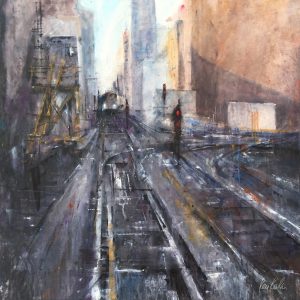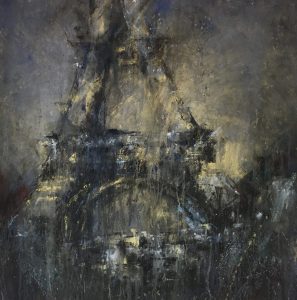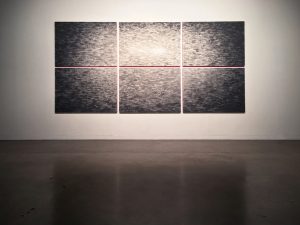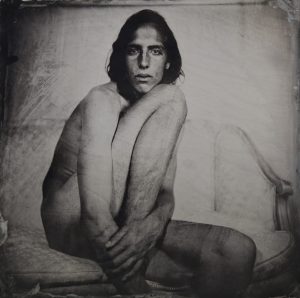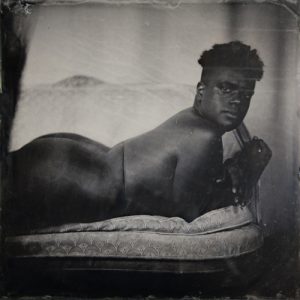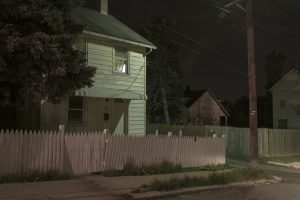October 1 – 27, 2018
Artist Talk/Reception: Thursday, October 11, 11:30am-12:30pm
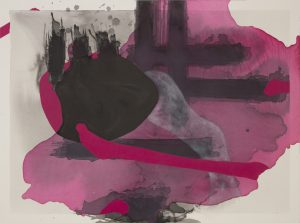
Spirit of the Day offers viewers an essential yet often forgotten engagement—a deeper connection with their own spirit in the contemporary busy society. The paintings present a moment of this spiritual engagement through mindfully cultivated marks on the surface. Sumi-ink brings out subtle and nuanced shifts in values and highlights a myriad of layers so that viewers may lost in them and find the core of humanity.
Spirit of the Day
“When I say ‘I am’, I am really including everyone else. We are all connected.”
– Nishiki Sugawara-Beda
Nishiki Sugawara-Beda cultivates feelings of honest connection in Spirit of the Day. Sugawara-Beda draws from Japanese culture and language, her own immigration experience, and family life to create these works. Her paintings are exercises in spiritual connection and mindfulness. The artist works in Sumi ink, a staple in Japanese calligraphy. This choice was made largely to hold fast to Japanese culture after moving to the United States. She remembers fondly the slow, laborious practice of making Sumi ink, which is done before one practices calligraphy and serves doubly as meditative preparation for the practice.
In earlier works, the artist uses Sumi ink to draw Japanese characters without picking up the brush, creating an abstract form from line and value. In time, the process evolved to create the lines and subsequent forms without drawing the characters, only by thinking of certain words and phrases.
Through this practice, Sugawara-Beda creates a medium through which she can communicate honestly with viewers. The paintings serve as an opportunity for viewers to engage meditatively with Sugawara-Beda. By getting lost in the lines, viewers see what they wish, learning about both themselves and the artist.
Spirit of the Day is on view in the Merion Hall gallery through October 27, 2018.
~ Devon D’Andrea ‘20
Gallery Exhibition Research Assistant
Inaugural & Hana
22″×30″, Sumi ink and acrylic on paper mounted on wood, 2017/2016
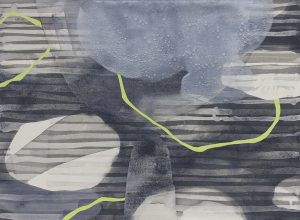
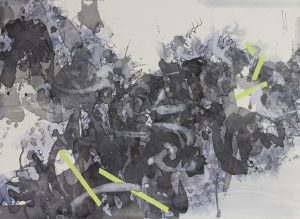
Inaugural, a series characterized by the color blue, was created when Sugawara-Beda became a new mother. After giving birth, the artist had to redefine herself as an artist and a person. These works explore the feelings of excitement and uncertainty associated with new motherhood while staying true to her core process. Additionally, this series is exemplary of Sugawara-Beda’s earlier works, when her process included drawing words and phrases before creating the line.

In contrast, Hana, “flower” in Japanese, did not start with written words. Instead, the artist remembered a story about a Zen teacher and his students.
“Traditionally, Zen practice is learned by question and answer between students and a teacher. One day, a teacher gathered his students, and they all stood ready to receive a question, but the teacher stood there in front of the students, holding a flower and smiling. Eventually, all of the students started to smile, too.” – Nishiki Sugawara-Beda
For the artist, Hana serves to communicate a positive feeling. With bright pinks and plunging lines, viewers feel a sense of contented peace.
How We See It
39.5″×141″, Sumi ink and acrylic on paper mounted on wood, 2018
This piece is a whole greater than the sum of its parts. For Sugawara-Beda, it was a study in her process. It is entirely abstract, and its interpretation is meant to be fluid. Viewers should see what they want to see in the painting. The artist wishes for the piece to serve as a tool in meditation. To engage with it is to engage with oneself and all of humanity.
~ Devon D’Andrea ‘20
Gallery Exhibition Research Assistant
